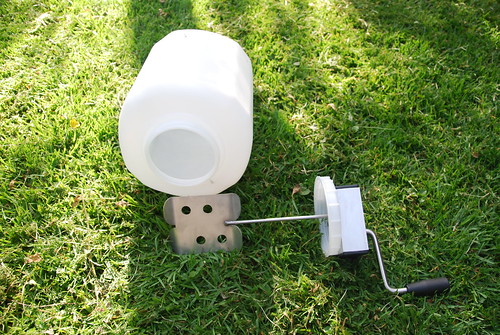Sidama's rural women are about to change their traditional way of butter processing
- The first test of new butter churn, with a large opening, capable of churning cream as well as milk took place in Arbagona District in the Sidama Zone
Helping Ethiopia’s rural women with butter processing
Women all over Ethiopia process milk into butter in rural households, perhaps with the exception of areas where consumption of milk in coffee or tea is common.
The LIVES project’s baseline surveys results also indicate that most households sell small quantities in local markets and this constitutes one of the income sources for women.
 Butter processing is based on age old traditions with local churns made of pottery or other local materials. Women process soured milk which is accumulated over a 2 to 5 day period. Because most households produce only small quantities of milk each day, women in some locations form groups to collectively process the soured milk from the group members in one churn. This reduces the individual labour time spent on churning by each woman.
Butter processing is based on age old traditions with local churns made of pottery or other local materials. Women process soured milk which is accumulated over a 2 to 5 day period. Because most households produce only small quantities of milk each day, women in some locations form groups to collectively process the soured milk from the group members in one churn. This reduces the individual labour time spent on churning by each woman.
Nevertheless, the volume of soured milk churned are usually small (less than 10 litres) and time-consuming in terms of processing time per litre of milk or kg of butter. Many years ago, ILCA adjusted the local churn and developed a mechanism to reduce labour and increase butter extraction. However efficiency gains were limited, which probably contributed to low adoption rates. Some NGOs and companies introduced hand-operated bigger-sized stainless steel butter churns (up to 20 litres). However these were targeted to small-scale private and/or cooperative dairy processing companies in and around district towns. Adoption in rural areas is zero, since the churns are relatively expensive and therefore uneconomical for use by private households or small informal groups.
Comparing household-level butter processing methods in rural areas with the small-scale commercial butter processing in (peri-)urban areas shows up interesting differences. In rural areas, the whole (soured) milk is processed, while in urban areas only the cream (fluid) is processed. The cream is removed from the milk with a mechanical cream separator. Applying this principle of (sour) fat/cream churning in rural areas would be possible without the use of the cream separator, since fat/cream would naturally settle on top of the milk over time and can be removed manually. Big open containers would be required however to create and remove the cream manually. The collected cream can then be transferred to the churners and be processed into butter. The narrow neck of the traditional churn may be unsuitable to pull out larger quantities of butter extracted from cream. We will test the validity of this assumption at a later stage.
Given these facts, the LIVES project imported a cheaper, 10 litre hard plastic new butter churn, with a large opening, capable of churning cream as well as milk. The first test took place in Arbagona District in the Sidama Zone.

The LIVES team used seven litres of soured milk for each churn and conducted churning with the participation of farmers and extension staff. There were some differences in churning time and butter extraction, but the magnitude of the differences was small. On average, about 450 gr of butter was produced from 7 litres of soured milk in about 51 minutes with the traditional churn and in 66 minutes with the new churn. However, using the new churn to process 7 litres of cream obtained from 50 litres of milk resulted in 2.3 kg of butter. Processing time was 65 minutes, which is about the same as the time required to produce 450 gr of butter from 7 litres of soured milk. The participants made several observations on the new churn, including; lack of ventilation hole in the churn, butter granules sticking to the (inside) wall of the churn, shape of the rotor/agitator insufficient to churn milk/cream in the upper part of the container. Also churning cream was harder for the women than churning (soured) milk.
The implications of the quantitative data observed so far suggest that processing cream from 50 litres of milk with the new churn results in less butter (2.3 kg) than processing 50 litres of soured milk (3.2 kg) with the new or traditional churn. However big gains can be made in (female) labour savings i.e. 65 minutes to process the cream of 50 litres of milk using the new churn, as compared to 364 minutes to process 50 litres of soured milk using the traditional churn. Expressed in terms of processing time per litre of milk and kg of butter, the new churn takes respectively 1.3 min/l of milk and 28.3 min/kg of butter, while the traditional soured milk method with traditional churn will take 7.3 min/l milk and 113.3 min/kg of butter.
These potential gains should be discussed in the rural communities to create interest in small scale processing of butter from soured cream by either womens’ groups or private individuals. Possible uses of the remaining soured skimmed milk should also be taken into consideration when discussing the business model.
The lessons from the qualitative assessments we learned so far are that technical adjustments should be made to the new churn to improve its efficiency in terms of time (and ease of use by women) and butter extraction. Additional testing will take place in other LIVES sites and be reported in our butter blog!!!
Story by Yoseph Mekasha, Tesfaye Shewage, Solomon Gizaw and Dirk Hoekstra
Source@lives-ethiopia.org




Comments
Post a Comment